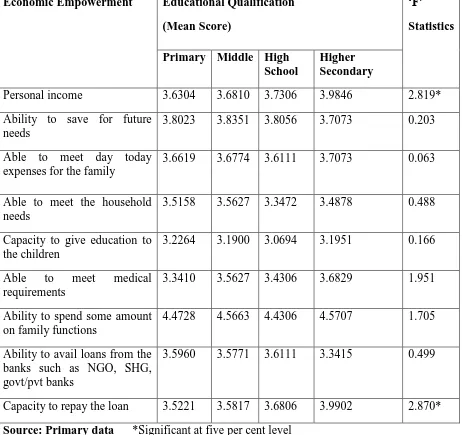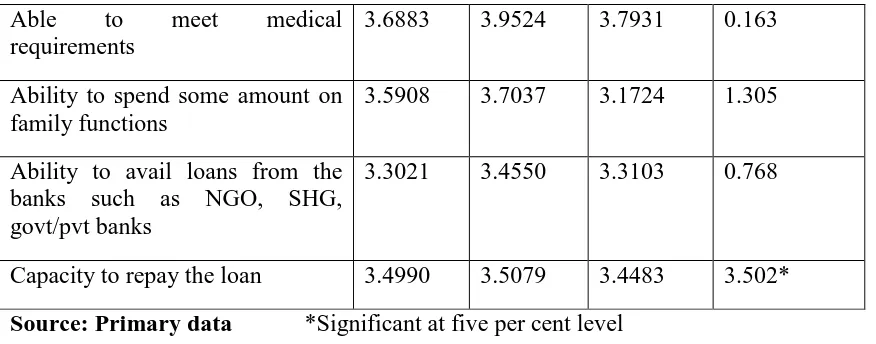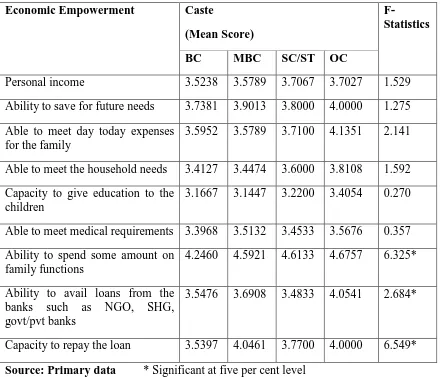International Research Journal of Management and Commerce Vol. 4, Issue 2, February 2017 Impact Factor- 5.564 ISSN: (2348-9766)
© Associated Asia Research Foundation (AARF)
Website: www.aarf.asia Email : editor@aarf.asia , editoraarf@gmail.com
ROLE OF MICRO FINANCE ON ECONOMIC EMPOWERMENT OF
UNORGANISED WOMEN WORKERS
Dr. P. Lourdes Poobala Rayen, T. Juliet Vinotha,
Head of the Department of Commerce, Assistant Professor in Commerce,
St. Xavier‟ s College (Autonomous), Annai Hajira Wome‟s College
Palayamkottai. Palayamkottai.
Introduction
Alleviation of poverty, the core of all developmental efforts has remained a very complex and
critical concern for developing countries. In spite of considerable improvement in the status
of women, they still comprise the largest section of deprived population. Empowerment of
women is seen as one of the most important means of poverty eradication. Lack of capital is a
serious constraint to the development of poor women in the rural, semi-urban and urban areas
who find little or no access to credit. Credit can help women to respond to the opportunities
created by the process of development. Micro finance is the provision of thrift, credit and
other financial services and products of very small amounts mainly to poor in rural,
semi-urban and semi-urban areas for enabling them to raise their income level and improve living
standards. Micro finance has become a key word with Governments, NGOs and international
institutions. It has proven to be an effective and popular measure in the ongoing struggle
against poverty as well as for women empowerment.
Objectives of the study
The main objective of this study is to analyse the economic empowerment of
unorganized women workers in relation to their social status.
The economic empowerment of unorganized women workers has been measured
day today expenses for the family, able to meet the household needs, capacity to give
education to the children, able to meet medical requirements, ability to spend some amount
on family functions, ability to avail loans from the banks such as NGO, SHG,
Government/private banks and capacity to repay the loan. Empowerment is a qualitative
variable which cannot be quantitatively measured, because level of empowerment cannot be
quantitatively measured. It is a relative term which cannot be relatively measured and
compared with one unorganized women worker to other. Hence in quantifying the qualitative
variable namely level of empowerment of the unorganized women worker scaling technique
is employed. The qualitative variable namely empowerment is assessed through scaling
technique
Economic Empowerment among different Age group of Unorganised women workers
Unorganised women workers of different age groups have different economic
empowerment. In order to find out the significant difference in economic empowerment
among different age group of unorganized women workers in Tirunelveli district, „ANOVA‟
test is attempted with the null hypothesis as, “There is no significant difference in
economicempowerment among different age group of unorganized women workers in
Tirunelveli district”. The result of „ANOVA‟ test for economic empowerment among
[image:2.595.66.531.497.775.2]different age group of unorganized women workers is presented in Table 1
Table 1
Economic Empowerment among different Age group of Unorganised Women Workers
Economic Empowerment Age Group (Mean Score)
F-Statistics 20-30
years
30-40 years
40-50 years
Above 50 years
Personal income 3.3585 3.6444 3.6425 3.6159 1.179
Ability to save for future needs 3.3774 3.7964 3.9412 3.7971 4.533*
Able to meet day today expenses for the family
3.7547 3.6657 3.7149 3.5507 0.531
Able to meet the household needs 3.2453 3.5167 3.5611 3.5435 0.806
Capacity to give education to the children
3.2264 3.0881 3.4434 3.0435 2.332
Ability to spend some amount on family functions
4.0943 4.4833 4.5294 4.5797 2.714*
Ability to avail loans from the banks such as NGO, SHG, govt/pvt banks
3.5660 3.5319 3.6787 3.5217 0.680
Capacity to repay the loan 3.5472 3.7173 3.8778 3.7536 1.453
Source: Primary data *-Significant at five per cent level
Table 1 shows the mean score of economic empowerment among different age group
of unorganized women workers along with its respective „F‟ statistics. The important
economic empowerment among the unorganized women workers are in the age group of 20
to 30 years are ability to spend some amount on family functions and able to meet day today
expenses for the family and their respective mean scores are 4.0943 and 3.7547. Among the
unorganized women workers are in the age group of 30 to 40 years, the important economic
empowerment are ability to spend some amount on family functions and ability to save for
future needs and their respective mean scores are 4.4833 and 3.7964. The important
economic empowerment among the unorganized women workers are in the age group of 40
to 50 years are ability to spend some amount on family functions and ability to save for future
needs and their respective mean scores are 4.5294 and 3.9412. Among the unorganized
women workers are in the age group of above 50 years, the important economic
empowerment are ability to spend some amount on family functions and ability to save for
future needs and their respective mean scores are 4.5797 and 3.7971. Regarding the economic
empowerment, the significant difference among the different age group of unorganized
women workers, are identified in the case of ability to save for future needs and ability to
spend some amount on family functions since the respective „F‟ statistics are significant at 5
per cent level, the null hypothesis is rejected.
Economic Empowerment among different educational qualification of Unorganised
women workers
Unorganised women workers of different educational qualification have different
economic empowerment. In order to find out the significant difference in economic
empowerment among different educational qualification of unorganized women workers in
Tirunelveli district, „ANOVA‟ test is attempted with the null hypothesis as, “There is no
significant difference in economic empowerment among different educational
„ANOVA‟ test for economic empowerment among different educational qualification of
[image:4.595.69.531.175.610.2]unorganized women workers is presented in Table 2
Table 2
Economic Empowerment among different Educational Qualification of Unorganised
women workers
Economic Empowerment Educational Qualification
(Mean Score)
„F‟
Statistics
Primary Middle High School
Higher Secondary
Personal income 3.6304 3.6810 3.7306 3.9846 2.819*
Ability to save for future needs
3.8023 3.8351 3.8056 3.7073 0.203
Able to meet day today expenses for the family
3.6619 3.6774 3.6111 3.7073 0.063
Able to meet the household needs
3.5158 3.5627 3.3472 3.4878 0.488
Capacity to give education to the children
3.2264 3.1900 3.0694 3.1951 0.166
Able to meet medical
requirements
3.3410 3.5627 3.4306 3.6829 1.951
Ability to spend some amount on family functions
4.4728 4.5663 4.4306 4.5707 1.705
Ability to avail loans from the banks such as NGO, SHG, govt/pvt banks
3.5960 3.5771 3.6111 3.3415 0.499
Capacity to repay the loan 3.5221 3.5817 3.6806 3.9902 2.870*
Source: Primary data *Significant at five per cent level
Table 2 shows the mean score of economic empowerment among different
educational qualification of unorganized women workers along with its respective „F‟
statistics. The important economic empowerment among the unorganized women workers
had primary education are ability to spend some amount on family functions and ability to
empowerment are ability to spend some amount on family functions and ability to save for
future needs and their respective mean scores are 4.5663 and 3.8351. The important
economic empowerment among the unorganized women workers had high school education
are ability to spend some amount on family functions and ability to save for future needs and
their respective mean scores are 4.4306 and 3.8056. Among the unorganized women workers
had higher secondary education, the important economic empowerment are ability to spend
some amount on family functions and capacity to repay the loan and their respective mean
scores are 4.5707 and 3.9902. Regarding the economic empowerment, the significant
difference among the different educational qualification of unorganized women workers, are
identified in the case of personal income and capacity to repay the loan since the respective
„F‟ statistics are significant at 5 per cent level, the null hypothesis is rejected.
Economic Empowerment among different religion of Unorganised women workers
Unorganised women workers of different religion have different economic
empowerment. In order to find out the significant difference in economic empowerment
among different religion of unorganized women workers in Tirunelveli district, „ANOVA‟
test is attempted with the null hypothesis as, “There is no significant difference in
economic empowerment among different religion of unorganized women workers in
Tirunelveli district”. The result of „ANOVA‟ test for economic empowerment among
[image:5.595.63.527.517.773.2]different religion of unorganized women workers is presented in Table 3.
Table 3
Economic Empowerment among different Religion of Unorganised women workers
Economic Empowerment Religion
(Mean Score)
F-Statistics
Hindu Christian Muslim
Personal income 3.5182 3.4921 3.6207 5.938*
Ability to save for future needs 3.1683 3.2434 3.3793 0.434
Able to meet day today expenses for the family
3.4493 3.4392 3.5862 0.230
Able to meet the household needs 4.4512 4.5979 4.4138 0.117
Capacity to give education to the children
Able to meet medical requirements
3.6883 3.9524 3.7931 0.163
Ability to spend some amount on family functions
3.5908 3.7037 3.1724 1.305
Ability to avail loans from the banks such as NGO, SHG, govt/pvt banks
3.3021 3.4550 3.3103 0.768
Capacity to repay the loan 3.4990 3.5079 3.4483 3.502*
[image:6.595.67.505.34.206.2]Source: Primary data *Significant at five per cent level
Table 3 shows the mean score of economic empowerment among different religion of
unorganized women workers along with its respective „F‟ statistics. The important economic
empowerment among the unorganized women workers belong to Hindu are able to meet the
household needs and able to meet medical requirements and their respective mean scores are
4.4512 and 3.6883. Among the unorganized women workers belong to Christian, the
important economic empowerments are able to meet the household needs and able to meet
medical requirements and their respective mean scores are 4.5979 and 3.9524. The important
economic empowerment among the unorganized women workers belong to Muslim are able
to meet the household needs and capacity to give education to the children and their
respective mean scores are 4.4138 and 3.8621. Regarding the economic empowerment, the
significant difference among the different religion of unorganized women workers, are
identified in the case of personal income and capacity to repay the loan since the respective
„F‟ statistics are significant at 5 per cent level, the null hypothesis is rejected.
Economic Empowerment among different caste of Unorganised women workers
Unorganised women workers of different caste have different economic
empowerment. In order to find out the significant difference in economic empowerment
among different caste of unorganized women workers in Tirunelveli district, „ANOVA‟ test
is attempted with the null hypothesis as, “There is no significant difference in economic
empowerment among different caste of unorganized women workers in Tirunelveli
district”. The result of „ANOVA‟ test for economic empowerment among different caste of
Table 4
Economic Empowerment among different Caste of Unorganised women workers
Economic Empowerment Caste
(Mean Score)
F-Statistics
BC MBC SC/ST OC
Personal income 3.5238 3.5789 3.7067 3.7027 1.529
Ability to save for future needs 3.7381 3.9013 3.8000 4.0000 1.275
Able to meet day today expenses for the family
3.5952 3.5789 3.7100 4.1351 2.141
Able to meet the household needs 3.4127 3.4474 3.6000 3.8108 1.592
Capacity to give education to the children
3.1667 3.1447 3.2200 3.4054 0.270
Able to meet medical requirements 3.3968 3.5132 3.4533 3.5676 0.357
Ability to spend some amount on family functions
4.2460 4.5921 4.6133 4.6757 6.325*
Ability to avail loans from the banks such as NGO, SHG, govt/pvt banks
3.5476 3.6908 3.4833 4.0541 2.684*
Capacity to repay the loan 3.5397 4.0461 3.7700 4.0000 6.549*
Source: Primary data * Significant at five per cent level
Table 4 shows the mean score of economic empowerment among different caste of
unorganized women workers along with its respective „F‟ statistics. The important economic
empowerment among the unorganized women workers belong to BC are ability to spend
some amount on family functions and ability to save for future needs and their respective
mean scores are 4.2460 and 3.7381. Among the unorganized women workers belong to
MBC, the important economic empowerment are ability to spend some amount on family
functions and capacity to repay the loan and their respective mean scores are 4.5921 and
4.0461. The important economic empowerment among the unorganized women workers
belong to SC/ST are ability to spend some amount on family functions and ability to save for
future needs and their respective mean scores are 4.6133 and 3.8000. Among the unorganized
women workers belong to OC, the important economic empowerment are ability to spend
some amount on family functions and able to meet day today expenses for the family and
the significant difference among the different caste of unorganized women workers, are
identified in the case of ability to spend some amount on family functions, ability to avail
loans from the banks such as NGO, SHG, govt/pvt banks and capacity to repay the loan since
the respective „F‟ statistics are significant at 5 per cent level, the null hypothesis is rejected.
Economic Empowerment among different marital status of Unorganised women
workers
Unorganised women workers of different marital status have different economic
empowerment. In order to find out the significant difference in economic empowerment
among different marital status of unorganized women workers in Tirunelveli district,
„ANOVA‟ test is attempted with the null hypothesis as, “There is no significant difference
in economic empowerment among different marital status of unorganized women
workers in Tirunelveli district”. The result of „ANOVA‟ test for economic empowerment
among different marital status of unorganized women workers is presented in Table 5
Table 5
Economic Empowerment among different Marital Status of Unorganised women
workers
Economic Empowerment Marital Status
(Mean Score)
F-Statistics
Married Unmarried Widowed Divorced
Personal income 3.6440 3.0606 3.5932 3.7778 3.587*
Ability to save for future needs 3.8018 3.3636 3.8898 4.0222 3.064*
Able to meet day today expenses for the family
3.6183 3.0303 3.8983 4.0889 5.652*
Able to meet the household needs
3.5009 2.9091 3.6610 3.7556 3.183*
Capacity to give education to the children
3.1431 2.2424 3.4322 3.9111 7.045*
Able to meet medical
requirements
3.4000 3.0000 3.6610 3.8667 4.181*
Ability to spend some amount on family functions
Ability to avail loans from the banks such as NGO, SHG, govt/pvt banks
3.5303 3.0909 3.7458 4.0444 4.530*
Capacity to repay the loan 3.8165 3.5152 3.5763 3.7333 1.853
Source: Primary data *Significant at five per cent level
Table 5 shows the mean score of economic empowerment among different marital
status of unorganized women workers along with its respective „F‟ statistics. The important
economic empowerment among the married unorganized women workers are ability to spend
some amount on family functions and capacity to repay the loan and their respective mean
scores are 4.5156 and 3.8165. Among the unmarried unorganized women workers, the
important economic empowerment are ability to spend some amount on family functions and
capacity to repay the loan and their respective mean scores are 4.1515 and 3.5152. The
important economic empowerment among the widowed unorganized women workers are
ability to spend some amount on family functions and able to meet day today expenses for the
family and their respective mean scores are 4.3898 and 3.8983. Among the divorced
unorganized women workers, the important economic empowerment are ability to spend
some amount on family functions and able to meet day today expenses for the family and
their respective mean scores are 4.6444 and 4.0889. Regarding the economic empowerment,
the significant difference among the different marital status of unorganized women workers,
are identified in the case of personal income, ability to save for future needs, able to meet day
today expenses for the family, able to meet the household needs, capacity to give education to
the children, able to meet medical requirements and ability to avail loans from the banks such
as NGO, SHG, govt/pvt banks since the respective „F‟ statistics are significant at 5 per cent
level, the null hypothesis is rejected.
Conclusion
Women empowerment is critical to the process of development of the economy. It
plays a critical role in the alleviation of poverty and in the all round progress of the nation.
Among the various measures targeted towards women empowerment, the provision of micro
finance assumes great importance. Evidences from successful experiments testify that micro
credit has helped to improve the status of women and has enabled the poor to expand and
[image:9.595.72.532.36.125.2]References
1.Kropp, Dr. Erhard W. & Suran Dr. B.S. (2002) Linking Banks and (Financial) Self Help
Groups in India – An Assessment, November, 2002
2.Abdul Raheem A. “Women‟s SHG for Alleviating Poverty”, Kisan World, Vol.52, No.4,
2005 3.http://ddpext.worldbank.org/





